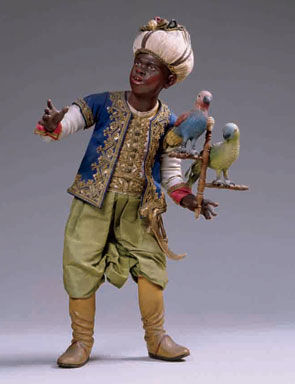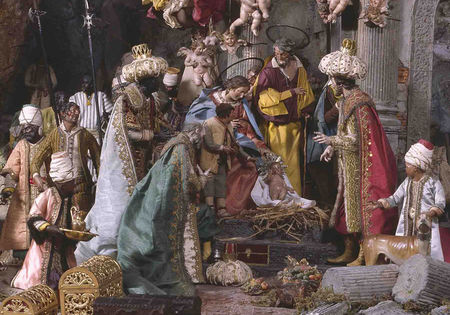A Nativity from Naples: Presepe Sculpture of the Eighteenth Century @ the Kimbell Art Museum
Felice Bottigliero and Francesco Gallo, Young African Page with Pair of Parrots, late 18th century, h. 11 3/4 in. Collection of the Catello family, Naples. Photo © Archivio dell’arte – Luciano Pedicini / fotografo (www.pedicinimages.com)
FORT WORTH, TX.- This Christmas season, the Kimbell Art Museum plays host to an extraordinary loan from Naples, Italy: a magnificent, 18th-century Neapolitan Nativity scene—known in Italian as a presepe after the Latin word for “manger,” praesepe. The Kimbell presepe will feature over 70 figures and animals (ranging up to about 15 inches tall) and be displayed in the traditional manner with a realistic, rocky setting. For those who have never stood face-to-face with an authentic Neapolitan Nativity scene, the level of detailing, craftsmanship, and artistry is sure to be astounding. Each of the figures is a triumph of miniature sculpture, and the Kimbell is heartily grateful to the private collectors in Naples—Roberto Catello, Giuseppe Lembo, and Mauro Scarlato—who have agreed to lend us examples of the highest quality. Other loans will be coming from the foremost public collection of presepe, the Museo Nazionale did San Martino, Naples. The Kimbell is tremendously indebted to the Polo Museale Napoletano and its superintendent, Nicola Spinosa, for helping to arrange these once-in-a-lifetime loans.
According to popular legend, St. Francis of Assisi founded the tradition of presepe when, in 1223, he reenacted the birth of Christ with live animals and actors at a town called Greccio in central Italy. In fact, such Nativity plays were much older, but it is undoubtedly true that with St. Francis there came a new desire to visualize Christ’s birth, and sculptural ensembles representing the Holy Family became a popular solution. During the Renaissance, presepe figures were generally large (often life-size) and installed in churches. Some of the very earliest ones were in stone. The shift to terracotta happened in the late 15th century, and with that we find the first presepe figures of great lifelikeness.
Throughout the 16th and 17th centuries, the tradition of presepe spread far and wide across Europe. It took exceptionally strong root in Naples during the 18th century, a period of great political stability and economic boom, and the wealthiest Neapolitans—including their Bourbon kings—commissioned ever more elaborate presepe for display in their palaces at Christmas. Four scenes were traditionally represented: the group of the Holy Family, the Adoration of the Magi, the Adoration of the Shepherds, and what is known as the Taberna, which consisted of groups of ordinary townspeople acting out scenes from everyday life. The Taberna was sometimes the dominant scene, as Neapolitans had long cherished popular imagery. Eighteenth-century presepe also included many figures of African or Middle Eastern origin. Naples sat at the crossroads of the Mediterranean, and Neapolitans were fascinated with the exotic people who passed through their city.
The presepe that will be assembled at the Kimbell this Christmas will include figures by all the greatest sculptors who were active in Naples during the 18th century. Some were famous marble carvers like Giuseppe Sanmartino, while others, like Francesco Gallo, specialized in porcelain products at the royal porcelain factory at Capodimonte. The one skill at which they all excelled was modeling in clay. They generally delegated the painting of the figures to specialists, while hiring actual tailors to sew the miniature clothes, which are astounding for their richness and detail. The exhibition will include displays dedicated to the techniques of presepe sculpture, where visitors can appreciate how figures were made—from the construction of the wooden or metal armatures to the modeling in clay to the insertion of miniature glass eyes.
A critical part of any presepe is the arrangement of the figures and the creation of the background scenography. The Kimbell will bring a team of installers from Naples to ensure that the Kimbell’s presepe is presented according to 18th-century practices. Supervising the operation will be the leading expert on presepe, Elio Catello, whose family has collected and installed presepe since the early 19th century. He learned the art from his grandfather, Vincenzo, and his father Roberto, and has passed it on to his daughter, Roberta, who will also accompany the presepe to the Kimbell and has been instrumental in selecting the figures.
Seeing a fully installed presepe is a rare treat. There are only a few museums where complete presepe can be viewed, and most are of much lesser quality than the one coming to the Kimbell. One of the most famous presepe in Europe is located in the Museo Nazionale di San Martino, Naples. For the most part, presepe figures are displayed singly, and it is only on extraordinary occasions—as with this loan to the Kimbell—that an ensemble is created and the complex art of the presepe is able to sing at its most glorious.
The Kimbell’s presepe will be on view throughout the holiday season, from November 25, 2008, to January 25, 2009. An illustrated book will accompany the display.
Cuciniello Presepe (detail with scenes of the Nativity and the Adoration of the Magi), 18th and 19th centuries. Museo Nazionale di San Martino, Naples. Photo © Archivio dell’arte – Luciano Pedicini / fotografo (www.pedicinimages.com)

/https%3A%2F%2Fprofilepics.canalblog.com%2Fprofilepics%2F1%2F0%2F100183.jpg)
/https%3A%2F%2Fstorage.canalblog.com%2F03%2F02%2F119589%2F96711876_o.jpg)
/https%3A%2F%2Fstorage.canalblog.com%2F11%2F31%2F119589%2F94773502_o.jpg)
/https%3A%2F%2Fstorage.canalblog.com%2F20%2F83%2F119589%2F94772815_o.jpg)
/https%3A%2F%2Fstorage.canalblog.com%2F26%2F72%2F119589%2F75604929_o.jpg)
/https%3A%2F%2Fstorage.canalblog.com%2F59%2F60%2F119589%2F26458628_o.jpg)




/http%3A%2F%2Fstorage.canalblog.com%2F24%2F07%2F119589%2F74304722_o.jpg)
/http%3A%2F%2Fstorage.canalblog.com%2F62%2F35%2F119589%2F73077683_o.jpg)
/http%3A%2F%2Fstorage.canalblog.com%2F65%2F14%2F577050%2F37681907_p.jpg)
/http%3A%2F%2Fstorage.canalblog.com%2F57%2F38%2F119589%2F34956204_o.jpg)